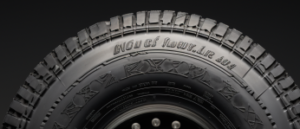Last Updated on April 22, 2024
Exploring the Benefits and Coverage of Tire Repair Warranties
Your vehicle’s tires are its only point of contact with the road, making them a critical aspect of your safety and driving experience. As a responsible driver, you likely understand the importance of proper tire maintenance and care. However, no matter how diligent you are, unexpected incidents can occur, leading to tire damage.
This is where a tire repair warranty comes into play, offering you peace of mind and financial protection in case of unforeseen tire issues. In this comprehensive guide, we’ll delve into the world of tire repair warranties, exploring what they entail, why they matter, and how they can benefit you as a vehicle owner.
Protect your tires from road hazards with our Tire Repair and Replacement Policy. We know that tires are an investment for you, especially for commercial trucks. That is why we offer our customers a Tire Repair and Replacement Policy.
Understanding Tire Repair Warranties
A tire repair warranty is essentially an assurance provided by tire manufacturers or retailers that covers specific types of tire damage. This coverage typically extends to damage caused by road hazards, such as nails, glass shards, or potholes. It acts as a safety net, reducing the financial burden of unexpected tire repairs or replacements.
Key Coverage Areas
- Puncture Repairs: Tire repair warranties often cover the cost of repairing punctures. If your tire sustains a hole from a nail or sharp object, the contract can save you from paying for the repair out of your pocket.
- Road Hazard Protection: These warranties commonly include protection against road hazards, like glass, debris, and potholes. The contract can cover the expenses if your tire incurs damage from these hazards.
- Tread-Life Guarantees: Some tire repair warranties offer tread-life guarantees, ensuring your tires last for a specified mileage. If your tires wear out prematurely, you may be eligible for a replacement or prorated refund.
Benefits:
- Cost Savings: One of the most significant advantages of a tire repair warranty is the potential for substantial cost savings. Unexpected tire repairs or replacements can be expensive, and these warranties help mitigate those costs.
- Peace of Mind: Knowing you have a safety net can provide peace of mind when you’re on the road. You won’t need to worry about the financial impact of sudden tire damage.
- Extended Tire Life: Tread-life guarantees offered by some warranties can extend the life of your tires. This means you get more value out of your tire investment.
- Convenience: With a tire repair warranty, you can often repair your tire quickly and easily. It minimizes downtime and inconvenience associated with tire issues.
Choosing the Right Tire Repair Warranty
Selecting the appropriate tire repair warranty involves considering a few key factors:
- Terms and Conditions: Carefully review the terms and conditions of the warranty to understand what is covered, what is excluded, and any limitations on coverage.
- Manufacturer vs. Retailer Warranties: Determine whether the tire manufacturer or the retailer offers the warranty. Both can be reputable, but their coverage and terms may differ.
- Coverage Period: Check the duration of coverage. Some warranties last for a specific mileage, while others have a time limit. Choose one that aligns with your driving habits.
- Additional Benefits: Some warranties may offer extras like tire rotation or roadside assistance. Consider whether these added perks are valuable to you.
- Professional Inspection: Regularly have your tires inspected by a qualified technician to identify any damage or issues that may be eligible for warranty coverage.

How do you opt for the tire coverage warranty?
SUV and light truck, RV/Trailer, and Commercial truck tires are eligible for this warranty. If the tire you are about to purchase is suitable for the contract, you can purchase this service during the checkout process. You will see the service cost per tire you added to your cart.
What is the Tire Repair and Replacement Policy offering?
The policy covers your tires for three years against damage from road hazards like nails, potholes, and glass shards. If you bought your tires from us and opted for the tire coverage, then your tires are protected for the next 36 months, from the date of purchase or until treadwear is worn 4/32 of an inch or less.
3- year protection
Your tires are protected for 36 months against damage from road hazards like Punctures, cuts, snags, and impacts or until treadwear is worn 4/32 of an inch or less.
Replacement up to total purchase price
You can get up to $100 of the original cost (at purchase price) if your tires become unserviceable because of a road hazard.
Repairs up to $40 per tire
If your damaged tire from a road hazard can be safely repaired, you will get reimbursed up to $40 per tire per occurrence.
Roadside assistance service included
In case of a flat tire, you can get free road assistance. Get reimbursed up to $100 for a flat tire changing service or towing if you don’t have a spare.
Certified technician support
Our certified technicians at our call center will be happy to assist you in arranging roadside assistance, finding service centers, and managing claims.
Tire Repair Technique
Indeed, here’s a brief explanation of a standard tire repairing technique called “Patch and Plug”:
Patch and Plug Technique:
- Assessment: Begin by inspecting the damaged tire. Locate the puncture or the source of the damage. Ensure that the damage is within the repairable limits and not too close to the sidewall or shoulder of the tire.
- Removal: If the tire has a foreign object, such as a nail or screw embedded in it, carefully remove the object using pliers or a similar tool.
- Reaming: Use a tire reaming tool to prepare the puncture area. This step involves slightly widening the puncture hole to ensure proper patch and plug materials adhesion.
- Cleaning: Thoroughly clean the puncture area and the surrounding tire surface. Remove debris, dirt, or moisture from the site to ensure a strong bond between the patch and the tire.
- Application of Patch: Apply a patch on the tire’s inner liner, covering the puncture hole. The patch is usually coated with a unique adhesive that bonds with the tire’s inner surface, creating an airtight seal.
- Insertion of Plug: Insert a plug, typically made of rubber or similar materials, into the puncture from the outside of the tire. Ensure that the plug completely seals the hole and prevents air from escaping.
- Trimming: Trim any excess material from the plug that protrudes from the tire’s surface, ensuring a smooth and even tread.
- Pressure Testing: Inflate the tire to the recommended pressure and perform a thorough pressure test to check for leaks or air loss.
- Visual Inspection: Conduct a final visual inspection to ensure the repair is secure and the tire’s integrity is maintained.
It’s important to note that trained professionals should perform tire repair techniques, as improper repairs can compromise tire safety. Not all tire damages are repairable, and some may require tire replacement for safety reasons. Always consult a qualified technician to determine the best action for your specific tire damage.
In Conclusion
A tire repair warranty protects you against unexpected tire damage, providing financial protection and peace of mind. With coverage for punctures, road hazards, and even tread-life guarantees, these warranties offer valuable benefits to vehicle owners. When selecting a contract, understand the terms, coverage period, and any additional benefits it provides.
Regular tire maintenance and professional inspections are essential to maximize the benefits of your tire repair warranty. You can enjoy worry-free driving with the proper contract, knowing unexpected tire issues won’t break the bank. Invest in your safety and financial security by exploring your tire repair warranty options today.
When it comes to tire repair, a tire repair warranty can be your safety net. It provides assurance and coverage for unexpected tire damage, ensuring your peace of mind on the road. Don’t compromise on your tire investment. Explore your options and protect your tires. Visit Truck Tires (https://www.tires-easy-truck.com) today and discover the benefits of tire repair warranties – because your safety and confidence matter.
Ready to dive deeper into the world of tires? Explore more informative articles on Tire Easy Truck’s website to enhance your tire knowledge!
- Commercial Truck Tires: A Guide to the Best Commercial Truck Tires
- Spotlight on Goodyear Commercial Truck Tires: Are You Ready to Hit the Road?
- Best commercial truck tires: Unlocking the Potential of Your Heavy-Duty Vehicle with Our Top 8 Picks Tires
FAQs
What is a tire repair warranty?
A tire repair warranty is a guarantee offered by tire manufacturers or retailers to cover certain types of damage that may occur to your tires, such as punctures or road hazards. It provides peace of mind that you won’t have to bear the total cost of tire repairs or replacements.
What does a tire repair warranty typically cover?
Tire repair warranties usually cover damage caused by common road hazards like nails, glass, or potholes. They may also include coverage for repairable punctures. It’s essential to read the specific terms and conditions of the warranty to understand the extent of coverage.
How does a tire repair warranty benefit me?
A tire repair warranty benefits you by reducing unexpected expenses related to tire damage. If your tire is eligible for repair under the warranty, you won’t have to pay for the repair or replacement, which can save you money and provide peace of mind while driving.
Is a tire repair warranty the same as a tire manufacturer’s warranty?
No, they are different. A tire manufacturer’s warranty typically covers issues related to the tire’s manufacturing defects and artistry. On the other hand, a tire repair warranty explicitly addresses damage caused by external factors like road hazards.
What is repairable tire damage?
Repairable tire damage refers to common types of tire issues that can be safely and effectively repaired without needing a tire replacement. This includes punctures, minor cuts, and damage caused by road hazards like nails or glass, provided the damage is within certain limits.
What are the methods of tire repair?
Tire repair methods typically involve patching or plugging the damaged area. Patching consists of repairing the tire’s inner liner while sealing the puncture from the outside. Both approaches aim to restore the tire’s integrity and prevent air leakage.
What is the best method of tire repair?
The best tire repair method depends on the damage type and location. Patching and plugging are often considered the most effective and safe approach. However, it is crucial to consult a professional tire technician who can assess the damage and recommend the appropriate repair method.
Is it possible to repair a tire?
Many tire damages can be repaired, extending the tire’s life and saving you the replacement cost. However, it is essential to note that not all tire damage is repairable. The size, location, and type of damage are critical factors in determining whether a tire can be safely repaired. Consulting a qualified tire technician is essential to make this assessment accurately.









